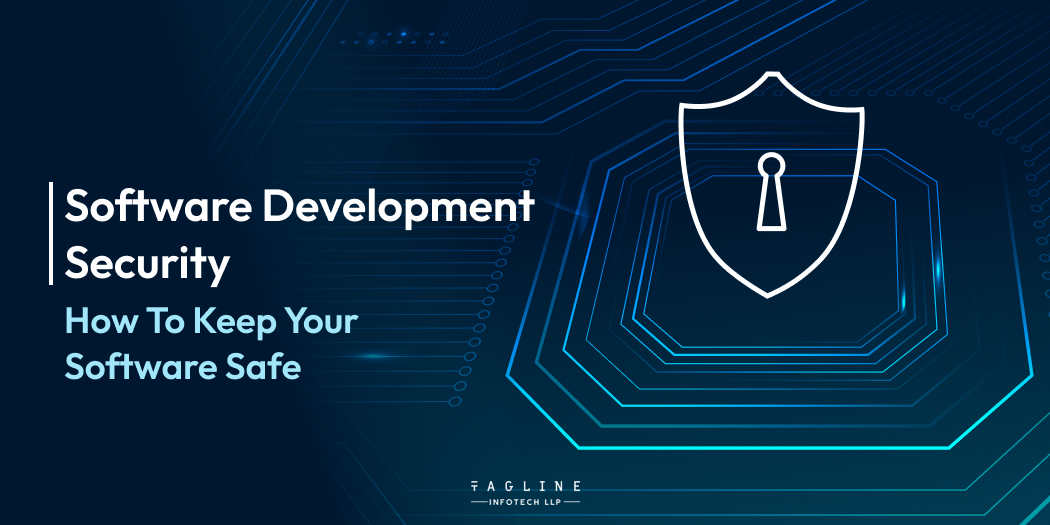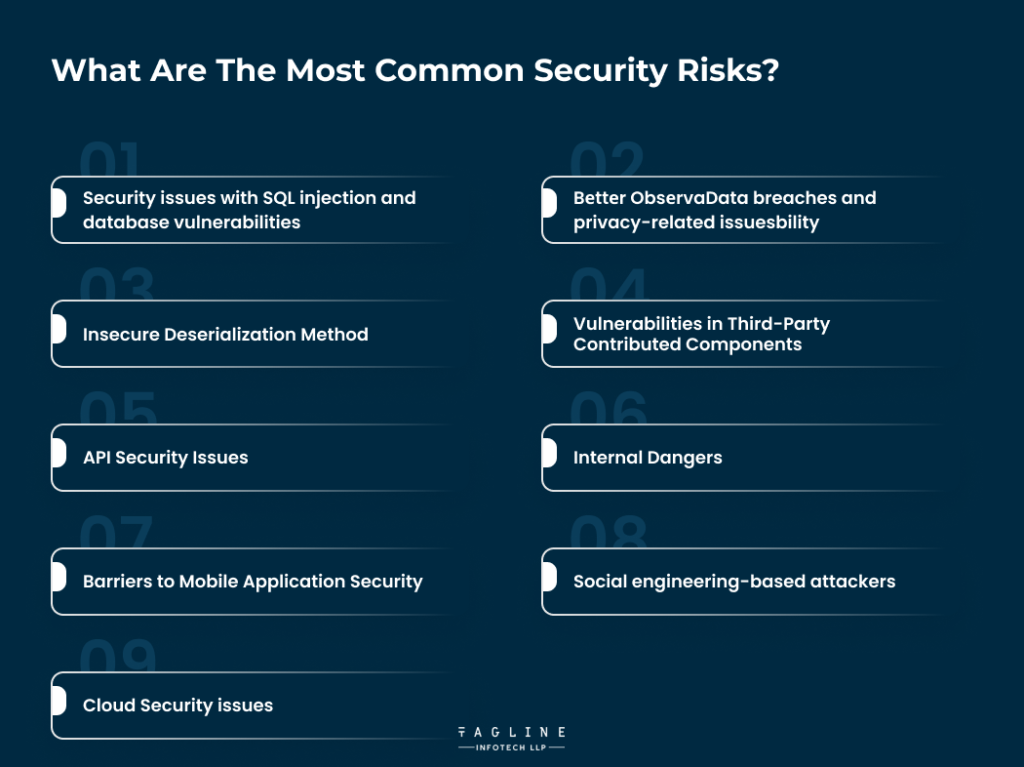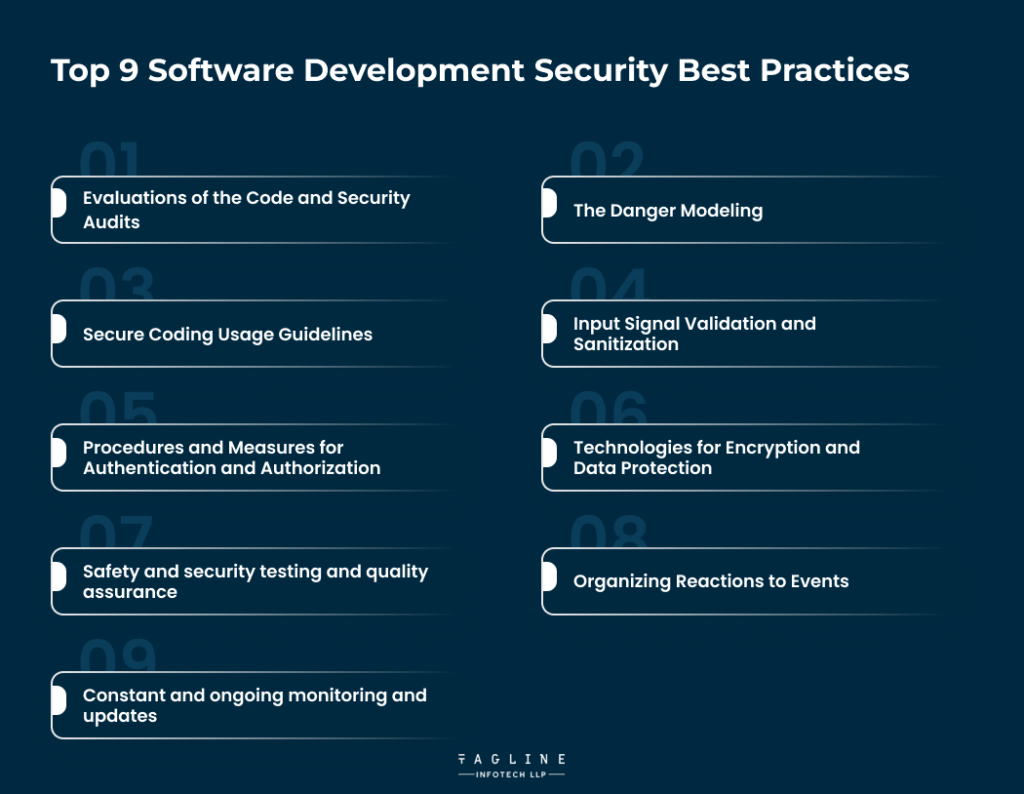A List of The 25 Best Ruby on...
May 8, 2024
Home >> Software >> Software Development Security: How To Keep Your Software Safe

Quick Summary
This article explores the critical need to give security priority during the software development lifecycle. It provides insight into the most common threats, the best practices, and the justifications for disregarding security. This blog’s goal is to demonstrate why, to create software that is trustworthy and failure-resistant, resilient security methods must be incorporated across the whole development lifecycle.
The procedures and safety measures used to protect software from hostile attacks and unauthorized access are referred to as software development security. It is an essential element when it comes to data protection and preserving user trust.
The importance of this measure for developers and organizations alike cannot be overstated in the current era of digital technology. Ignoring this element puts you at danger of suffering large financial losses. To give one more example, consider that the average cost of a data breach worldwide in 2023 was $4.45 million USD, a notable 15% increase over the preceding three years.
The costs related to breaches were far higher in some businesses than others, with an average of $10.10 million, $9.82 million, and $8.77 million, respectively, in the healthcare, financial, and technology sectors. These concerning numbers highlight the importance of security and its role in software development.
We shall discuss its significance and the different implementation strategies in greater detail in the next article.
Security in software development refers to the methods used to protect programs from possible threats. This specific attribute is crucial for maintaining both the data’s integrity and consumers’ trust. Measures are taken to guard against threats and vulnerabilities as part of this procedure.
These guidelines ensure that software will remain secure for the duration of its existence. From concept to implementation, security ought to be the top priority at every stage.
There is attention given to the risks associated with the infrastructure, application use, and code. Robust security techniques that are now being developed can avert significant breaches and losses.
Reliability and security in digital products are dependent on this region of specialization. Any software development project must have a firm grasp of its concepts and procedures.
“Softwarе Development Automation: Thе Nеw Era of Softwarе Dеvеlopmеnt “
– Also Read Article

SQL injection attacks are directed at an application’s database layer. They take advantage of weaknesses in applications that rely on data to steal or manipulate data for their nefarious purposes. Sensitive data may become accessible to unauthorized individuals due to these attacks.
To prevent SQL injection, two essential elements are to employ parameterized queries and rigorous input validation. Applying these suggestions in practice is one of the most crucial parts of creating safe software.
Data breaches pose a serious threat to both the company’s brand and customer privacy. Weaknesses and inadequate security measures are often the cause of a sizable portion of these incidents. To ensure that data breaches are prevented, development companies must use robust encryption and access controls. To lessen these risks, it is essential to do frequent security audits and train staff members.
The dangerous deserialization process creates significant security weaknesses that allow attackers to run harmful code. It happens when data that cannot be trusted is used to manipulate the logic of an application.
Preventing this from occurring requires validating all of the data before deserialization. Implementing security measures like whitelisting and input validation can increase software development security.
When third-party components are present in software systems, vulnerabilities may arise. Attackers could exploit these external codes if they need to be sufficiently verified. Updating and conducting thorough security audits on components supplied by outside parties is essential.
A software development company’s priority should be to monitor and patch these components regularly. The dangers associated with integrating with other parties are decreased due to this proactive approach.
The vulnerability of application programming interfaces (APIs) to various attacks stems from their vital role in modern software. These risks include worries about things like unauthorized access to data, data breaches, and service interruptions.
Strict authorization and authentication procedures are necessary to safeguard application programming interfaces (APIs). Other crucial tasks include applying security updates and routinely scanning for vulnerabilities. These steps must be implemented immediately to ensure the security and integrity of the application programming interface (API).
Insider threats come from within an organization, such as those made by contractors or employees. These risks could involve data theft, system sabotage, or inappropriate use of access credentials.
To reduce these dangers, rigorous access controls must be implemented, and ongoing monitoring is required. There are two ways to significantly reduce the chance that these threats will materialize: keeping an eye on user behaviour and training employees on security best practices.
One of the specific security issues that mobile applications deal with is data leakage and unsafe data storage. These security holes may lead to significant privacy violations and data loss. Strong encryption and protocols must be put in place for secure communication.
Frequent security testing and updates are essential to secure software development. These security measures must be prioritized to maintain the integrity of mobile applications and users’ trust.
Social engineering attacks leverage human psychology rather than technology vulnerabilities. Psychological manipulation is a tactic used by attackers to force someone to divulge or grant access to sensitive information.
Employees must receive the training they need to recognize these tactics and react to them effectively. Strict verification procedures and awareness-raising are the two most crucial safeguards. One of the critical elements of developing highly secure software is implementing a proactive staff education program.
Although cloud systems offer efficiency and scalability, they also carry unique security threats. Insecure interfaces, account takeovers, and data breaches are all potentially deadly scenarios.
Any software development security plan must include comprehensive cloud-specific measures to address these concerns. Encryption of data during transmission and storage, along with the implementation of strict access controls, is crucial.
It is critical to comprehend these common security risks and take appropriate action to counter them. Utilizing this proactive approach ensures a safer and more robust software development process.
Elevate your software development practices with robust security measures!
Connect with us our team are specializing in Software Development Security

Conduct thorough code reviews and security audits to find vulnerabilities early on. These methods ensure that the code is safe to use and appropriate for the intended use. Peer participation in the code review process facilitates the quick identification and fixing of any possible security issues.
Security audits, conducted regularly, are used to assess the overall security health of software. The proactive approach being taught here is one of the most significant features of best practices for software development.
Threat modeling is the practice of identifying possible weaknesses and dangers in the early stages of development. This process aids in raising understanding of the security implications of design choices. By creating software, programmers can model various attack scenarios and so anticipate and mitigate potential hazards. Investing in safety software development can help to make your software more secure.
Threat modeling can be used into the development lifecycle to increase software development security. As a result, the group is able to create much more secure systems and countermeasures.
Respecting secure code guidelines is essential for preventing common security vulnerabilities. These standards cover a number of best practices, such as input validation, error handling, and encryption.
When creating secure code that is impervious to attacks, it is advantageous to follow these well-established guidelines. Using secure coding concepts is a fundamental part of software development best practices. They provide a framework that enables the creation of dependable and secure applications.
Sanitization and input validation are critically important to stop injection attacks. As part of these steps, data cleansing and verification are done before processing starts. The amount of potential vulnerabilities can be significantly reduced by making sure that only legitimate and secure input is accepted.
Data sanitization is a useful security measure to prevent malicious code from running on the system. Using this approach is one of the most crucial parts of ensuring software development security.
To protect user identities and data, strong permission and authentication processes are necessary. The aforementioned actions are crucial parts of software development best practices. While authentication serves to confirm users’ identities, authorization controls resource access.
A multi-factor authentication system can be implemented to achieve an even higher level of security. Regular monitoring and upgrading of these security measures can help in the discovery and prevention of unlawful access.
Encryption is a must-have when it comes to protecting data during storage or transmission. Encryption safeguards the confidentiality and integrity of information in the unlikely event that it is intercepted. It is advised that for data that is in transit, strong encryption protocols like SSL/TLS be used.
Furthermore, data encryption during storage keeps information from being accessed by unauthorized parties. Data protection via encryption is a crucial element in order to guarantee the security of software development. It keeps consumers’ trust in the system intact and guards against data breaches.
To ensure that software is robust, security testing and quality assurance are both crucial steps in the process. These methods are crucial elements of security testing for software development. Regular penetration tests, security audits, and code reviews can help identify such vulnerabilities early on.
Software integrity and reliability can be ensured by the use of thorough quality assurance processes that prioritize security. These are crucial actions to maintain the high security levels needed for software development.
Having an extensive incident response plan is vital for effectively handling security breach situations. This type of plan lays out the steps that must be taken in order to locate, contain, and resolve security vulnerabilities. Having frequent training sessions and maintaining an updated response plan guarantees prompt and efficient action
An efficient incident response strategy is necessary to lessen the detrimental effects of security occurrences. This is a vital component that resilient software development security frameworks have to have.
Updating software and doing ongoing monitoring are crucial steps in maintaining efficient software security. The implementation of this technique involves the ongoing observation of system functions to detect and promptly address potential risks. Effective monitoring and updating is one of the most crucial best practices for software development.
Automated methods are useful for continuous monitoring since they can quickly identify unusual activity and potential security holes. Installing security updates together with routine software upgrades is crucial for safeguarding against evolving and new threats.
In conclusion, safeguarding your software demands a proactive commitment to robust security measures. You should hire software developers if you are trying to get most secure software for your business. By embracing a holistic approach that integrates secure coding practices, regular assessments, and vigilant monitoring throughout the development lifecycle, you fortify your software against potential threats, ensuring a resilient and safe digital environment.
The developers can use user-friendly authentication methods like biometrics or single sign-in. Plus, you can even get feedback from users to see whether they are satisfied with the software or not.
Yes, the security of your software won’t be compromised if you regularly update the third-party libraries that you integrated and ensure that these libraries aren’t vulnerable.

Digital Valley, 423, Apple Square, beside Lajamni Chowk, Mota Varachha, Surat, Gujarat 394101
+91 9913 808 2851133 Sampley Ln Leander, Texas, 78641
52 Godalming Avenue, wallington, London - SM6 8NW